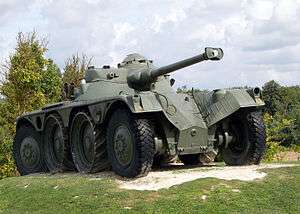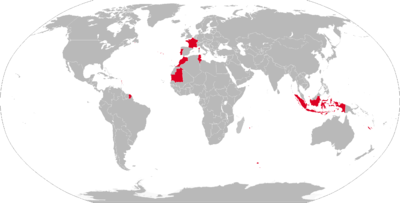Panhard EBR
The Panhard EBR (Panhard Engin Blindé de Reconnaissance, French: Armored Reconnaissance Vehicle) is an armoured car designed by Panhard for the French Army and later used across the globe, notably by the French Army during the Algerian War and the Portuguese Army during the Portuguese Colonial War in Angola, Mozambique and Guinea-Bissau.
| Panhard EBR | |
|---|---|
 | |
| Type | Armoured car |
| Place of origin | France |
| Service history | |
| Used by | French Army Indonesian Army Portuguese Army |
| Wars | Algerian War Portuguese Colonial War Indonesia-Malaysia Confrontation |
| Production history | |
| Produced | 1951-1960 |
| No. built | 1179 |
| Specifications | |
| Mass | from 12.7 tonnes (14.0 short tons; 12.5 long tons) to 13 tonnes (14 short tons; 13 long tons) |
| Length | 6.15 m (20 ft 2 in) |
| Width | 2.42 m (7 ft 11 in) |
| Height | 2.24 m (7 ft 4 in) 2.32 m (7 ft 7 in) (eight wheels deployed) |
| Crew | 4 |
| Armor | Hull front 40 mm Hull sides 20 mm Turret 40 mm |
Main armament | SA 49 75mm rifled gun (mle 51) SA 50 75mm rifled gun (mle 54) CN 90 F2 90 mm low-pressure gun (mle 51 revalorisé) |
Secondary armament | 3× 7.5 mm MAC31 Reibel machine guns most common, sometimes 4 x 7.5 mm MGs 4× DREB smoke dischargers |
| Engine | Panhard 12 H 6000 S flat-twelve gasoline engine 200 hp at 3700 RPM |
| Power/weight | 15.6 hp/tonne |
| Suspension | spring |
Operational range | 700 km (430 mi)[1] |
| Maximum speed | up to 115 km/h (71 mph)[1] |
Development history
The EBR is an 8x8 wheeled reconnaissance vehicle based on the previous Panhard AM 40 P/Model 201, a light armoured car born before the Second World War, but remained only at prototype level. After the war the new contest for a postwar armoured car saw the Panhard proposal as winner against other two french firms. Despite the two basic concepts developed with the M.201 were retained (8 wheels and oscillating turret), the new armoured car was a new project, much heavier (13 t vs 8), more crewed (4 vs 2), with a 75 mm gun (vs 25 mm) and with many other innovation, included a new anti-bullet tyres and very sloped armour, double pilot and machine gun inside the hull nose and aft. The production only started after several years of testing, as Modele 51 in 1950 (limited production), followed by full production in 1954 with over 1200 vehicles being manufactured until 1960. While being lightly armoured, the EBR was armed with the 90 mm FL-11 or 75 mm cannon known as the FL-10 or L/48 in a novel oscillating turret and supported by up to four 7.5 mm machine guns: one coaxial with the main gun, one operated by the driver, one by the co-driver, and one by the commander, though the latter was not found on all EBRs. The EBR had a crew of four (including two in the turret),[2] and was powered by a 200 hp (150 kW) 6 liter[3] 12HD horizontally opposed air-cooled 12-cylinder engine (with dual carburetors and 6.6:1 compression, enabling it to run on low-octane petrol).[3] Based on Panhard's two-cylinder automobile engine, it was mounted under the floor of the fighting compartment, which had the unfortunate effect of requiring the turret to be removed to conduct major engine repairs.[3]
Designed in 1951 by Panhard, OBE used a symmetrical front and rear with two driver positions. The EBR can reach speeds of 100 km/h (62 mph) on 14 in (36 cm)-wide, 24 in (61 cm)-diameter wheels with Michelin tyres and Veil-Picard tubes, which feature a series of nitrogen-filled cells, enabling them to absorb bullet hits and not go flat.[3] The armoured hull is mounted on an 8-wheel drive, with 4 inner metal wheels, which can be raised for driving on the road. The four central wheels have aluminum rims with steel grousers, separated by rubber blocks;[3] with all eight wheels deployed, ground pressure is only 0.7 kg (1.5 lb) per 1 cm2 (0.16 in2).[3]
The 1954 model improves armaments with a lengthened 75 mm barrel, giving a muzzle velocity of 1000 m/s. Finally, the 1963 version further strengthens firepower with a 90 mm gun. An armoured personnel carrier derivative known as the Engin Transport de Troupes (ETT) was produced for export, but only 28 were ever produced (for Portugal).[4]
Service history
France has, since 1935, engaged in the manufacture and use of a prolific line of wheeled armored reconnaissance vehicles armed with weapons with an anti-tank capability. This being the result of reforms initiated by the Light Mechanized Divisions (DLM).
French tactical doctrine required reconnaissance elements to cover and range over a large and extensive battlefield, especially within the context of the slow and high-maintenance tanks of the time. Also of note is the way that tanks are best deployed, massed and concentrated, which prevents their dispersion for safety and for screening.
It is a particular trait of French reconnaissance vehicles to be heavily armed. From the prewar MD 178 armed with an anti-tank gun of 25 mm, (which was for the period a significant caliber for such a small vehicle) to the direct successor of the EBR, the AMX 10 RC, also used for wheeled reconnaissance, and armed with a powerful 105 mm gun with automatic firing, firepower equal to a main battle tank of the 1980s. A pattern repeated in the AML 90 and the ERC 90 Sagaie.
These reconnaissance systems are not only aimed at discovery and investigation (missions that can be fulfilled by lighter vehicles with lighter weapons), but also with security missions upon the battlefield (for example flank-security and offensive protection) which requires a substantial firepower not only to destroy the enemy advance elements, but also to oppose armoured incursions.
A turretless Panhard EBR vehicle carried the coffin of the late French president Charles de Gaulle at his state funeral.[5][6]
Portugal ordered 50 EBRs and 28 ETTs in 1956.[4] After the outbreak of the Portuguese Colonial War, most of these vehicles were sent to Lisbon's African colonies for counter-insurgency operations, especially Portuguese Mozambique.[4] During the Carnation Revolution, an EBR 75 FL10 of the Armed Forces Movement confronted an M47 Patton crewed by loyalist troops in the Praça do Comércio.[4] The crews of both vehicles eventually stood down without incident.[4]
Aside from Portugal and a few newly emerging Francophone states in North Africa, the only export sales of the EBR were a few small quantities produced for the Indonesian Army and the West German Bundesgrenzschutz.[4]
Characteristics
- Crew: 4 men (1 vehicle commander, 1 gunner, 1 driver, 1 rear driver)
- Length: 6.15 m
- Width: 2.42 m
- Height: 2.24 m
- Weight with combat: 13 tons
- Horsepower: 200 hp
- Range: 630 km
- Road speed: 105 km / h
- Tanks: 380 l
- Fuel consumption: 50l / 100 km
- Ammunition: 56 rounds (75 mm) or 43 rounds (90 mm)[3]
Weaponry
- Main armament (version 1951): 1 Canon 75 mm SA 49 (Vo 600 m / s)
- Main armament (version 1954): 1 Canon 75 mm SA 50 (Vo 1000 m / s)
- Main armament (version 1963): 1 Canon 90 mm model D921/F1 (Vo 750 m / s)
- Secondary armament: 3 machine guns of 7.5 mm, shipper magazines of 149 cartridges 1 inert.
Operators

Gallery
See also
- AMX 50
- AMX-13
- SK-105 Kürassier
Notes
- Centre de Documentation sur les Engins Blindés. Les chars français du Musée des Blindés (in French). Association des Amis du Musée des Blindés. p. 29.
- Ogorkiewicz, R. M. AFV Weapons Profile 039 Panhard Armoured Cars (Windsor, Berks: Profile Publications).
- Ogorkiewicz.
- Dunstan, Simon (2019). Panhard Armoured Car: AML 60, AML 90, Eland. Haynes Manuals. pp. 26–27, 124–125. ISBN 978-1-78521-194-2.
- "Archived copy". Archived from the original on 2016-03-05. Retrieved 2013-11-23.CS1 maint: archived copy as title (link)
- http://www.avbf.fr/wp-content/uploads/2013/07/char-EBR.jpg
- David Jordan. The History of the French Foreign Legion: From 1831 to Present Day (2005 ed.). Amber Books Ltd. pp. 181–185. ISBN 1-59228-768-9.
- "Trade Registers". Armstrade.sipri.org. Retrieved 2013-06-20.
- Nerguizian, Aram; Cordesman, Anthony (2009). The North African Military Balance: Force Developments in the Maghreb. Washington DC: Center for Strategic and International Studies Press. p. 27. ISBN 978-089206-552-3.
References
- Duncan Crow & Robert J. Icks, Encyclopaedia of Armoured Cars
- Ogorkiewicz, R. M. AFV Weapons Profile 039 Panhard Armoured Cars. Windsor, Berks: Profile Publications.
.jpg)